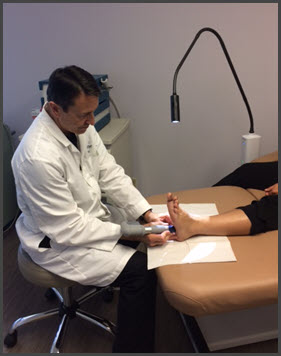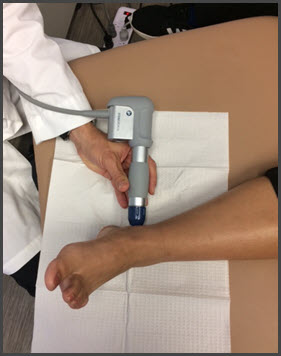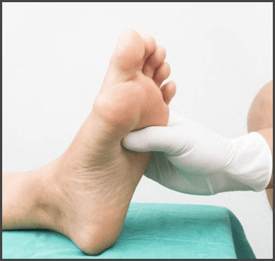Dr. Kleis Successfully Treats Diabetic Neuropathy with EPAT
For patients with diabetic neuropathy, EPAT (Extracorporeal Pulse Activation Technology) provides considerable relief. It works so well that, for physicians like Jeffery Kleis, DPM, it's become the standard treatment his patients rely on to treat their pain.
With over 25 years’ experience, Dr. Kleis believes in utilizing advanced technology and less invasive options to treat foot problems whenever possible. We recently sat down with him to discuss how he uses shockwave therapy to treat diabetic neuropathy.
Q: What are the causes and symptoms of neuropathy?
 A: Neuropathy is a common problem primarily for diabetics, but it can also occur due to chemotherapy, alcoholism and exposure to heavy metals. Other times, we can’t find a direct cause for this type of nerve damage. In terms of symptoms, some people experience numbness or tingling. Others have burning or severe pain with super sensitivity when they walk. Pain can be so severe that it keeps patients awake at night.
A: Neuropathy is a common problem primarily for diabetics, but it can also occur due to chemotherapy, alcoholism and exposure to heavy metals. Other times, we can’t find a direct cause for this type of nerve damage. In terms of symptoms, some people experience numbness or tingling. Others have burning or severe pain with super sensitivity when they walk. Pain can be so severe that it keeps patients awake at night.
Q: Why is EPAT a good treatment option?
A: Before I started using EPAT, there weren’t a lot of good treatment options out there. Oral medications like Neurontin can help control symptoms, but they have side effects like drowsiness so a lot of people can’t take them, particularly during the day.
Q: How long have you been using EPAT to treat diabetic neuropathy?
A: We’ve been treating neuropathy with EPAT for the past eight years. I bought my device from CuraMedix in 2011 and we use it on a daily basis.
Q: What does a typical treatment protocol look like?
 A: Usually we’ll do a trial of EPAT treatment weekly or every other week. We use 1,500 to 2,000 pulses per foot which takes just a few minutes. If patients respond after three or four treatments, we continue, usually every two weeks, until they reach the maximum benefit. Then they come in every four to six weeks to help them maintain the results.
A: Usually we’ll do a trial of EPAT treatment weekly or every other week. We use 1,500 to 2,000 pulses per foot which takes just a few minutes. If patients respond after three or four treatments, we continue, usually every two weeks, until they reach the maximum benefit. Then they come in every four to six weeks to help them maintain the results.
Q: How do you know that treatment is working?
A: We chart patient progress using the visual pain scale to measure changes in pain level. Of the 15 or so patients we treat every week, I’d say that 90% are reporting a significant improvement from EPAT treatment. Equally important, I don’t think I’ve ever had a patient who said their symptoms worsened after EPAT.
I’ve also had patients, for whatever reason, stop coming in for EPAT and their neuropathy got significantly worse. The good news is when treatment is resumed, they experience relief again.
Q: Do you use any other treatment options instead of or in conjunction with EPAT?
A: In addition to EPAT, we also offer laser treatment for neuropathy. However, I would say that, for patients that have had both laser and EPAT treatments, at least nine times out of 10, patients prefer EPAT for the increased relief it provides.
 Q: How do patients respond?
Q: How do patients respond?
A: Patients love it. It lessens their symptoms tremendously which helps them function better and have a higher quality of life. We’ve also helped a lot of patients get off medication which they appreciate. Many say they actually look forward to coming in, because when the leave, their feet feel great.
Q: What would you say to a physician who’s considering purchasing an EPAT device?
A: It’s an expense, but it’s also a purchase you won’t regret. Patients respond favorably and physicians like to refer for it because it works, it’s not invasive and has no side effects. It’s also an effective treatment for a variety of other pathologies we see like plantar fasciitis, Achilles tendinitis and wound care. I’ve used my device to treat so many patients over the years that I only wish I had purchased it sooner.
Don’t miss our related article, What Is the EPAT Protocol for Diabetic Neuropathy?
Interested in Learning More About EPAT/ESWT?
Dr. Kleis’s experience is not unique. EPAT/ESWT is evidence-based and clinically proven to treat pain. Want to learn more? Download this highly informative white paper, The Art of Shockwave.



